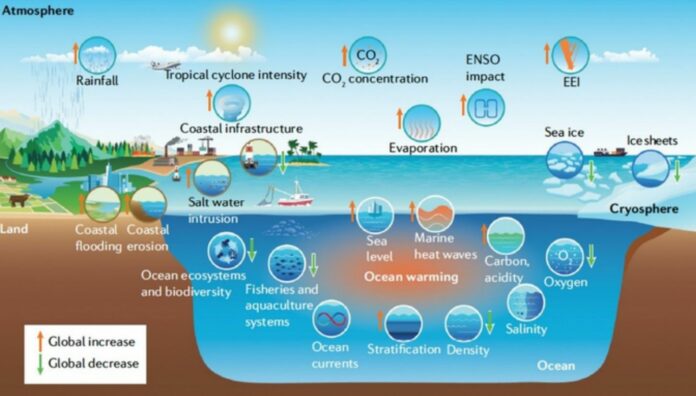A new study published in Nature Reviews provides fresh information about how much the world has warmed and how much warming we may expect in the future decades.
This study is significant because it inspires us to take steps to slow down and address climate change. It illustrates what will occur if we do nothing to stop the pace of global warming.
Earth warms as a result of human emissions of greenhouse gases into the atmosphere. More than 90% of the heat is absorbed by the ocean.
Therefore, we must look to the ocean and monitor changes in ocean heat content if we are to comprehend how quickly the Earth’s climate is changing.
The answer to comprehending our past and future lies in the ocean. As a crucial part of the Earth system, ocean warming also links the cycles of energy, carbon, and water.
Leading institutions from China, France, the USA, Australia, and the UK were among the participants in this extensive assessment, which comprised scientists from all over the world. Using a range of temperature sensors, the scientists gathered data on water temperatures from around the world.
Many of these temperature sensors are autonomous devices that float in the water or are tethered, like a buoy or mooring. Some of these temperature sensors are manually deployed in the oceans by researchers.
By piecing together data from thousands of temperature readings collected all across the world, scientists were able to see trends in ocean heat content dating back to the 1950s.
Multiple datasets tracking ocean warming have been compiled using these measures. After carefully evaluating each dataset’s reliability in light of recent advances in the area, the authors were able to determine how quickly the ocean has warmed.
They discovered that warming in the higher 2000m started beyond a doubt at least in the 1950s. Since then, the warming has intensified. The rate of the upper 2000m ocean warming is now more than doubling, from about 5 to 10 ZJ per year.
From the 1960s to the 2010s, a ZJ is equal to 1,000,000,000,000,000,000,000 Joules of energy. To put this into perspective, the USA consumes about 0.1 ZJ of energy annually. Sea levels are steadily rising as a result of the accompanying ocean expansion and land-based ice loss.
Second, we can foresee the ocean’s future state with reasonable accuracy. Scientists use historical measurements to make predictions about the future.
The most crucial conclusion is that we are responsible for the ocean’s future. The acceleration of ocean warming will slow down around 2030 if significant reductions in greenhouse gas emissions are implemented, or if the Paris Agreement’s goal of keeping global surface temperatures below 2°C above pre-industrial levels can be met.
But if we don’t do anything, the predictions are not very good. Throughout the 21st century, the rate of warming will skyrocket; by the 2090s, it is predicted that the rate of ocean warming would be four times more than it is now.
Although it is expected that all ocean basins would continue to warm throughout the 21st century, the report also discovered that some ocean regions are warming more quickly than others.
For instance, the Pacific Ocean and Indian Ocean are warming far more slowly than the Atlantic Ocean and southern oceans. Due to its size, the Pacific Ocean is predicted to surpass all other heat reservoirs by the end of this century.
The authors were able to demonstrate how excess heat can travel across the earth via water currents when it enters the ocean.
When the ocean gets warmer, it has huge effects on the Earth. not just to marine life, but also to global weather patterns, as well as to the food chain.
A warming ocean causes more powerful typhoons and hurricanes, more violent storms, and more devastating rains and flooding. Parts of the earth will become drier as a result of global warming, and there will be more heat waves and droughts.
As rain pours in heavier downbursts, other areas will get wetter. Coastal areas are becoming more and more susceptible as a result of rising sea levels, storm surges, and negative effects on ecosystems.
Numerous climate disasters, including heat waves, flooding, severe rains, major hurricanes, etc., have already occurred in 2022. If you think the weather right now is crazy, wait until the decades to come; we haven’t seen anything yet.
Source: 10.1038/s43017-022-00345-1
Image Credit: Getty
You were reading: When Will Humans Finally Be Able To Control Earth Warming?
